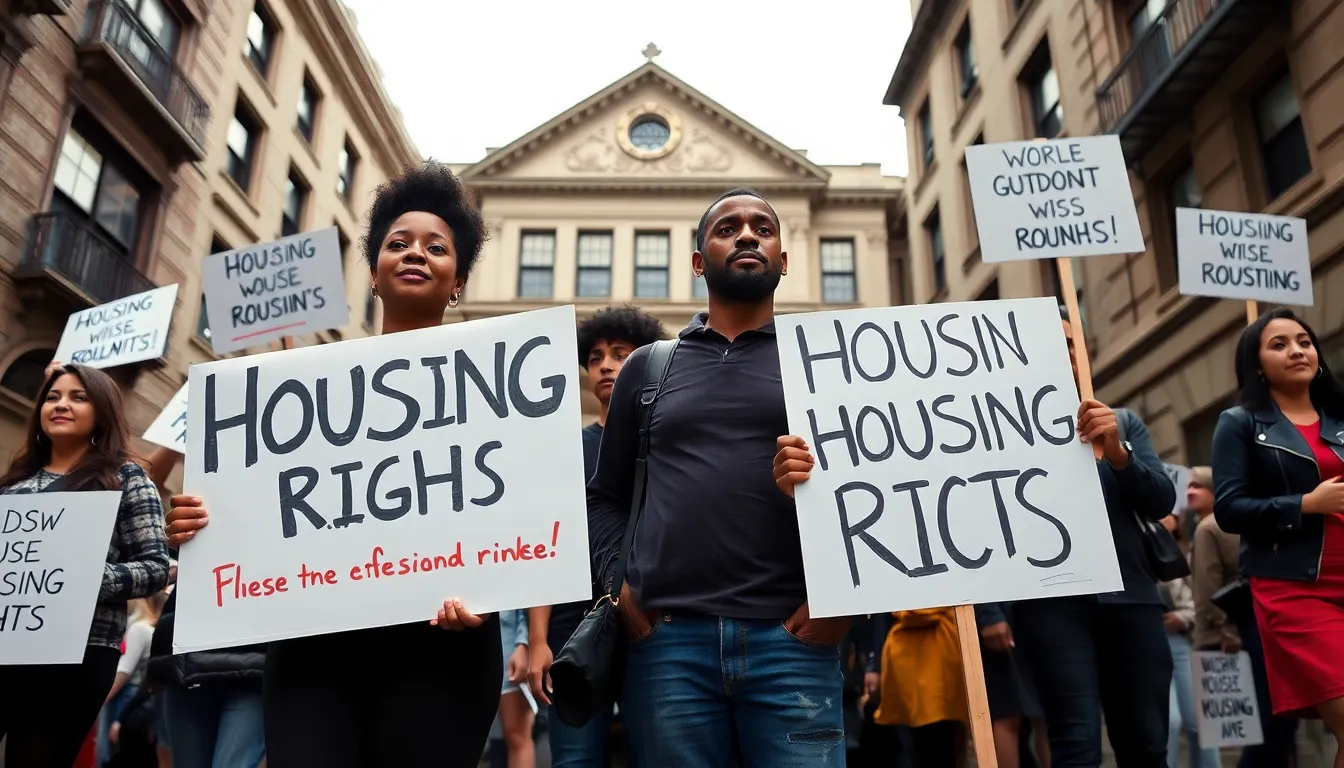Table of Contents
ToggleImagine coming home after a long day, only to be greeted by leaky ceilings, drafty windows, and a distinct aroma of something that definitely shouldn’t be there. Not exactly the cozy retreat one dreams of, right? The right to habitable housing is more than just a fancy phrase tossed around in legal circles; it’s a fundamental necessity for a happy and healthy life.
In a world where everyone deserves a place to call home, understanding this right can be a game-changer. It’s about ensuring that every roof over one’s head is not just a shelter but a sanctuary. Dive into the essentials of what makes housing habitable, and discover why it’s not just a luxury—it’s a right that everyone should enjoy. After all, who wouldn’t want to live in a place that feels like a warm hug instead of a cold, damp dungeon?
Overview of the Right to Habitable Housing
The right to habitable housing ensures access to safe and healthy living conditions. This fundamental right encompasses factors like stability, safety, sanitation, and affordability. Inhabitable homes protect occupants from environmental hazards such as mold, poor ventilation, and extreme temperatures.
Established in various legal frameworks worldwide, this right underscores the obligation of governments to provide adequate housing for all citizens. National and local laws may define minimum standards for housing, detailing necessary amenities such as clean water, electricity, and proper waste disposal. Additionally, this right promotes inclusive communities by encouraging diverse housing options.
Nonprofit organizations and advocacy groups play an essential role in monitoring housing conditions and advocating for improvements. These entities work to raise awareness about the significance of habitable housing, helping to bridge gaps in existing laws. Their efforts often result in initiatives aimed at reforming housing policies, ensuring all individuals can live in dignified conditions.
Impact extends beyond individual well-being, as access to habitable housing shapes public health and economic outcomes. Studies demonstrate that poor housing correlates with negative health indicators and higher healthcare costs. Furthermore, affordable housing fosters stability, helping families secure jobs and access education.
Ultimately, adherents to the right to habitable housing emphasize the need for continuous progress. Advocating for changes not only addresses existing issues but also paves the way for future generations to thrive in safe and secure environments.
Historical Context
The right to habitable housing has evolved significantly over time. Growing recognition of housing rights reflects societal changes and increased awareness of human dignity.
Development of Housing Rights
The development of housing rights traces back to early legislation on public health and urban planning. Historical movements highlighted the need for safe living conditions. Reformers advocated for standards addressing sanitation and safety in homes. Over decades, various social justice movements pushed for these rights to be recognized universally. By the mid-20th century, foundational documents like the Universal Declaration of Human Rights acknowledged housing as a fundamental necessity. Advocacy groups began to emerge, focusing on securing adequate housing for marginalized populations.
Key Legislation and Policies
Key legislation surrounding housing rights laid groundwork for modern frameworks. The Fair Housing Act of 1968 marked a pivotal moment, prohibiting discrimination in housing. Subsequent policies further defined expectations for safe and habitable living spaces. Local, state, and federal governments implemented regulations to ensure access to basic utilities, such as clean water and electricity. Environmental and health standards became integral in the conversation around housing. Legal frameworks established minimum conditions that governments must meet to uphold individuals’ rights to sufficient housing.
Key Components of Habitability
Habitability hinges on several critical components that together ensure a safe and comfortable living environment. Understanding these elements strengthens the case for adequate housing for all.
Essential Services and Amenities
Access to essential services defines habitable housing. Clean water stands as a vital necessity. Regular maintenance of plumbing and heating systems ensures warmth and sanitation. Electricity must be functional to support daily activities and appliances. Additionally, secure waste disposal systems contribute to a healthy living space. Communities with reliable transportation, grocery stores, and healthcare services also enhance overall livability. Recognizing these elements highlights the framework necessary for comfortable and sustainable living.
Safety and Health Standards
Safety regulations underpin the very foundation of a habitable space. Building codes outline structural integrity and adequate fire exits, ensuring residents’ safety. Electrical and plumbing systems must adhere to health standards to prevent hazards. Mold, pests, and other health risks require immediate attention to maintain a clean environment. Regular inspections by local authorities often enforce these safety protocols. Proper ventilation allows for airflow, reducing airborne contaminants. These combined factors create a healthy atmosphere essential for physical and mental well-being.
Legal Perspectives
Legal frameworks shape the right to habitable housing, illustrating ongoing struggles and advancements. Case law often exemplifies how legal systems uphold or challenge this right.
Case Studies and Precedents
Various case studies highlight the impacts of legal decisions on housing conditions. In California, the Lungren v. State of California case set a precedent by affirming tenants’ rights to habitable living conditions. Another notable case, Morris v. Harris, showed how courts enforced a landlord’s duty to provide essential amenities, ensuring tenants could seek remedies against unlivable conditions. These examples underscore the importance of legal action in advocating for habitable housing, illustrating how courts can compel enforcement of safety and health standards.
Challenges in Enforcement
Enforcement of habitable housing laws faces significant challenges. Many tenants fear retaliation for reporting unsafe conditions, discouraging them from pursuing legal remedies. Additionally, understaffed housing agencies often struggle to implement regulations effectively. Resource limitations on both local and state levels hinder proactive inspections and enforcement of existing laws. Without adequate funding or support, many housing issues remain unaddressed, leaving vulnerable populations at risk. These enforcement gaps highlight the necessity for strengthened policies to ensure the right to habitable housing is upheld consistently.
Global Comparisons
The right to habitable housing varies significantly across different countries, reflecting unique social, economic, and political contexts.
Different Approaches Worldwide
Countries adopt various legal frameworks to protect this right. Some nations, like Finland, have implemented housing-first policies aimed at providing permanent residences for those experiencing homelessness. Others, such as Brazil, focus on social housing programs that create inclusive communities. In Japan, local governments emphasize disaster-resilient housing due to the frequent natural calamities. Furthermore, European countries often integrate tenant protection laws that enhance housing security. Each approach demonstrates diverse strategies for addressing housing rights and maintaining standards.
Successes and Failures in Implementation
Success in implementing the right to habitable housing often depends on strong political will and community engagement. In Germany, policies that ensure extensive tenant protections resulted in improved living conditions and minimal homelessness. The Netherlands also ranks highly in housing quality due to progressive regulations and active support programs. Conversely, failures in countries like the United States reveal gaps in enforcement. Reports indicate that tenants frequently face unsafe living environments despite existing laws. Numerous cases illustrate the struggle of marginalized populations who often lack adequate resources to advocate for their rights. These patterns showcase the ongoing challenges and achievements in securing habitable housing globally.
Conclusion
The right to habitable housing is essential for fostering healthy and vibrant communities. Ensuring access to safe and comfortable living conditions not only enhances individual well-being but also strengthens societal resilience. Continuous advocacy and reform are vital to address existing gaps in housing rights and to promote equitable living environments for all.
As awareness grows around the significance of habitable housing, the collective efforts of governments, nonprofit organizations, and communities can drive meaningful change. By prioritizing safe housing as a fundamental human right, society can pave the way for a future where everyone has the opportunity to thrive in secure and welcoming spaces.





